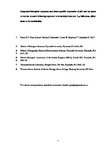Integrated biological responses and tissue-specific expression of p53 and ras genes in marine mussels following exposure to benzo(α)pyrene and C 60 fullerenes, either alone or in combination
| dc.contributor.author | Di, Y | |
| dc.contributor.author | Aminot, Y | |
| dc.contributor.author | Schroeder, DC | |
| dc.contributor.author | Readman, JW | |
| dc.contributor.author | Jha, Awadhesh | |
| dc.date.accessioned | 2017-01-06T08:52:38Z | |
| dc.date.issued | 2017-01 | |
| dc.identifier.issn | 0267-8357 | |
| dc.identifier.issn | 1464-3804 | |
| dc.identifier.uri | http://hdl.handle.net/10026.1/8212 | |
| dc.description.abstract |
We used the marine bivalve (Mytilus galloprovincialis) to assess a range of biological or biomarker responses following exposure to a model-engineered nanoparticle, C60 fullerene, either alone or in combination with a model polycyclic aromatic hydrocarbon, benzo(α)pyrene [B(α)P]. An integrated biomarker approach was used that included: (i) determination of 'clearance rates' (a physiological indicator at individual level), (ii) histopathological alterations (at tissue level), (iii) DNA strand breaks using the comet assay (at cellular level) and (iv) transcriptional alterations of p53 (anti-oncogene) and ras (oncogene) determined by real-time quantitative polymerase chain reaction (at the molecular/genetic level). In addition, total glutathione in the digestive gland was measured as a proxy for oxidative stress. Here, we report that mussels showed no significant changes in 'clearance rates' after 1 day exposure, however significant increases in 'clearance rates' were found following exposure for 3 days. Histopathology on selected organs (i.e. gills, digestive glands, adductor muscles and mantles) showed increased occurrence of abnormalities in all tissues types, although not all the exposed organisms showed these abnormalities. Significantly, increased levels of DNA strand breaks were found after exposure for 3-days in most individuals tested. In addition, a significant induction for p53 and ras expression was observed in a tissue and chemical-specific pattern, although large amounts of inter-individual variability, compared with other biomarkers, were clearly apparent. Overall, biological responses at different levels showed variable sensitivity, with DNA strand breaks and gene expression alterations exhibiting higher sensitivities. Furthermore, the observed genotoxic responses were reversible after a recovery period, suggesting the ability of mussels to cope with the toxicants C60 and/or B(α)P under our experimental conditions. Overall, in this comprehensive study, we have demonstrated mussels as a suitable model marine invertebrate species to study the potential detrimental effects induced by possible genotoxicants and toxicants, either alone or in combinations at different levels of biological organisation (i.e. molecular to individual levels). | |
| dc.format.extent | 77-90 | |
| dc.format.medium | Print-Electronic | |
| dc.language | en | |
| dc.language.iso | en | |
| dc.publisher | Oxford University Press (OUP) | |
| dc.subject | Animals | |
| dc.subject | Benzo(a)pyrene | |
| dc.subject | Bivalvia | |
| dc.subject | Comet Assay | |
| dc.subject | DNA | |
| dc.subject | DNA Damage | |
| dc.subject | Fullerenes | |
| dc.subject | Gene Expression Regulation | |
| dc.subject | Glutathione | |
| dc.subject | Models, Animal | |
| dc.subject | Organ Specificity | |
| dc.subject | Oxidative Stress | |
| dc.subject | Tumor Suppressor Protein p53 | |
| dc.subject | ras Proteins | |
| dc.title | Integrated biological responses and tissue-specific expression of p53 and ras genes in marine mussels following exposure to benzo(α)pyrene and C 60 fullerenes, either alone or in combination | |
| dc.type | journal-article | |
| dc.type | Journal Article | |
| dc.type | Research Support, Non-U.S. Gov't | |
| plymouth.author-url | https://www.webofscience.com/api/gateway?GWVersion=2&SrcApp=PARTNER_APP&SrcAuth=LinksAMR&KeyUT=WOS:000397070600008&DestLinkType=FullRecord&DestApp=ALL_WOS&UsrCustomerID=11bb513d99f797142bcfeffcc58ea008 | |
| plymouth.issue | 1 | |
| plymouth.volume | 32 | |
| plymouth.publication-status | Published | |
| plymouth.journal | Mutagenesis | |
| dc.identifier.doi | 10.1093/mutage/gew049 | |
| plymouth.organisational-group | /Plymouth | |
| plymouth.organisational-group | /Plymouth/Admin Group - REF | |
| plymouth.organisational-group | /Plymouth/Admin Group - REF/REF Admin Group - FoSE | |
| plymouth.organisational-group | /Plymouth/Faculty of Science and Engineering | |
| plymouth.organisational-group | /Plymouth/Faculty of Science and Engineering/School of Biological and Marine Sciences | |
| plymouth.organisational-group | /Plymouth/REF 2021 Researchers by UoA | |
| plymouth.organisational-group | /Plymouth/REF 2021 Researchers by UoA/UoA06 Agriculture, Veterinary and Food Science | |
| plymouth.organisational-group | /Plymouth/REF 2021 Researchers by UoA/UoA06 Agriculture, Veterinary and Food Science/UoA06 Agriculture, Veterinary and Food Science MANUAL | |
| plymouth.organisational-group | /Plymouth/Research Groups | |
| plymouth.organisational-group | /Plymouth/Research Groups/Marine Institute | |
| plymouth.organisational-group | /Plymouth/Users by role | |
| plymouth.organisational-group | /Plymouth/Users by role/Academics | |
| plymouth.organisational-group | /Plymouth/Users by role/Researchers in ResearchFish submission | |
| dc.publisher.place | England | |
| dcterms.dateAccepted | 2016-09-30 | |
| dc.rights.embargodate | 2017-10-10 | |
| dc.identifier.eissn | 1464-3804 | |
| dc.rights.embargoperiod | 12 months | |
| rioxxterms.versionofrecord | 10.1093/mutage/gew049 | |
| rioxxterms.licenseref.uri | http://www.rioxx.net/licenses/under-embargo-all-rights-reserved | |
| rioxxterms.licenseref.startdate | 2017-01 | |
| rioxxterms.type | Journal Article/Review | |
| plymouth.funder | Elucidating the potential interaction of manufactured nanoparticles with polycyclic aromatic hydrocarbons: An integrated toxicogenomics approach::NERC |


